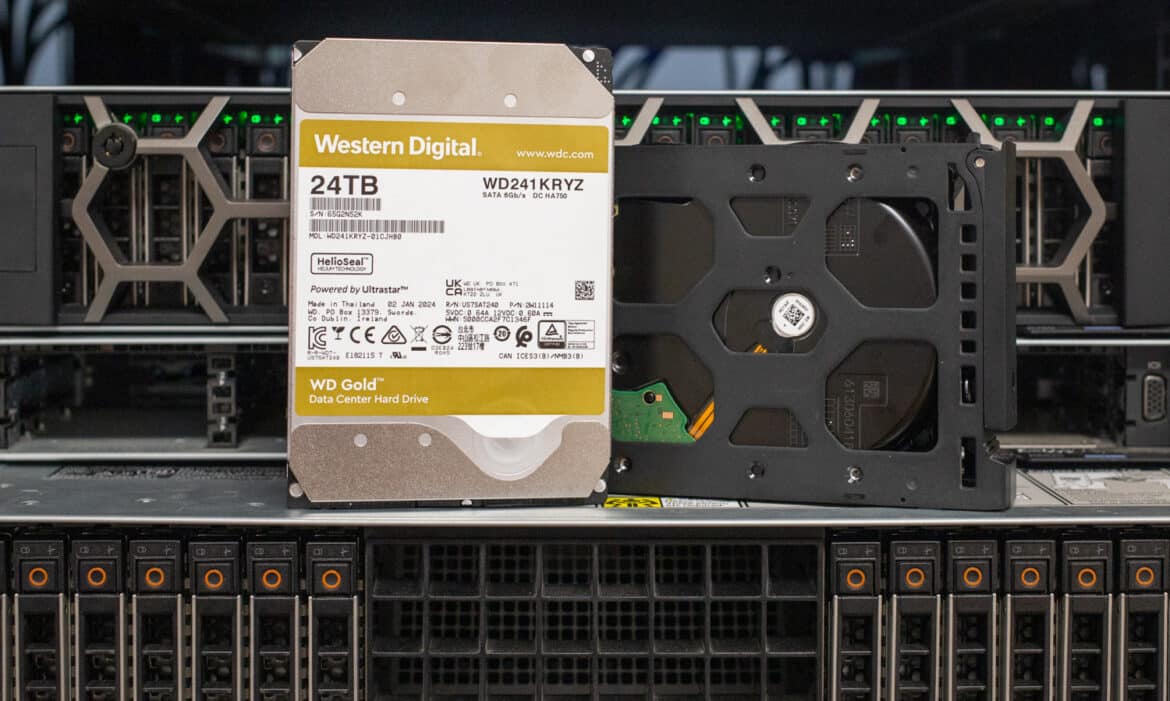The WD Gold 24TB Enterprise HDD offers a 2TB increase over its preceding 22TB model, a nice bump for dense storage servers.
In November 2023, WD introduced the 24TB Gold Enterprise HDD, offering a 2TB increase over its preceding 22TB model. While this update might seem modest, it represents a significant enhancement in storage capacity, particularly impacting storage density in large NAS and server configurations. Following our initial HL15 review, where we put fifteen WD Gold 24TB drives to the test, we’re now ready to revisit these drives in a standard 8-drive NAS system setup.
The WD Gold series is tailored to meet the diverse needs of businesses, providing a comprehensive range of enterprise-class HDDs from 1TB to 24TB. These drives are engineered to withstand demanding storage environments, boasting a MTBF of up to 2.5 million hours, vibration protection technology, and reduced power consumption through HelioSeal technology for models above 12TB.

WD Gold 24TB Features
WD has opted to release these high-capacity drives exclusively with a SATA interface, continuing the tradition of their helium-filled, 7200RPM CMR design, a staple of their lineup for several years. Interestingly, the new 24TB Gold model slightly reduces power consumption, utilizing 0.3 watts less during operation and 0.2 watts less in idle mode compared to its 22TB predecessor.

While the Gold HDD series spans capacities from 1TB to 24TB, it’s notable that the OptiNAND feature, including the innovative OptiNAND-enabled Armor Cache, is exclusive to models 20TB and larger. This technology synergizes the benefits of write cache enabled and disabled modes, offering users a blend of performance and data protection without the need to choose between the two.
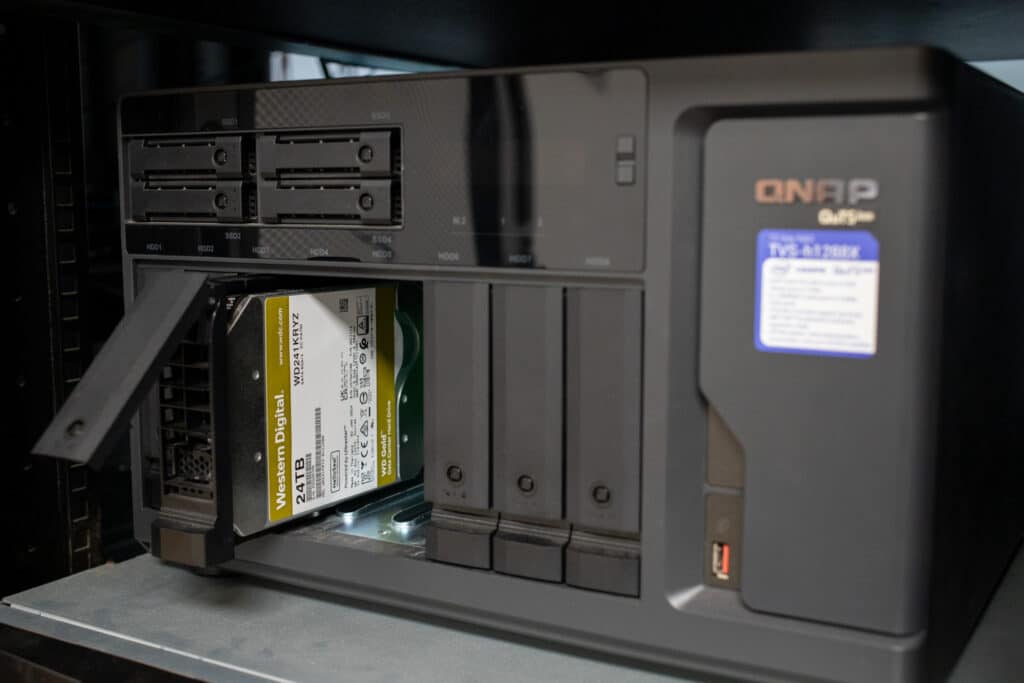
Furthermore, the WD Gold series offers flexibility and scalability for businesses, allowing for a customized storage setup that can handle intensive application workloads and support up to 550TB of data per year. This makes the WD Gold 24TB HDD a compelling option for enterprises looking to scale their data storage infrastructure while maintaining high levels of reliability and performance.
QNAP Storage & Snapshots Manager
Storage & Snapshots Manager is a versatile tool within the QNAP NAS interface that allows users to oversee and manage the various aspects of storage, including RAID configurations, disk health, and creating snapshots for data protection.
The Storage/Snapshots pane shows an overview of the storage volumes within the Storage Pool. In this example, it highlights the system volume and multiple iSCSI targets. The ‘Percent Used’ indicator bars provide a quick visual for the space utilization across different volumes.

The Storage Pool 1 Management window shows us that all drives are configured in a RAID 6 array, have a total capacity of 130.91 TB, and are in ‘Good’ condition. This indicates that everything is ready to go for our testing.
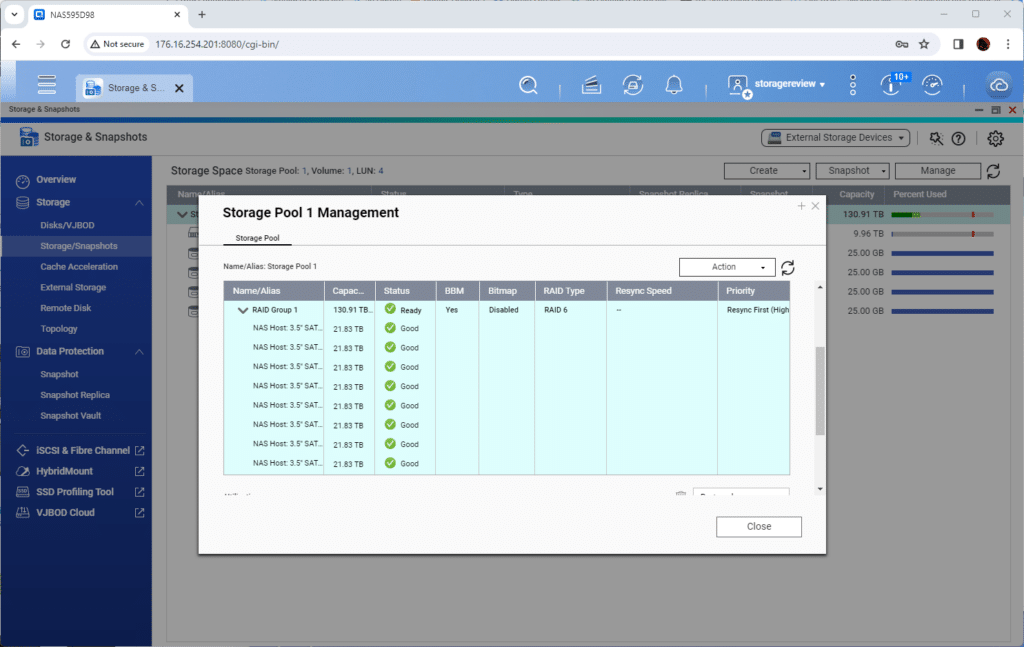
The image below shows the Disks/VJBOD section of the Storage & Snapshots Manager. Here, the ‘Good’ and ‘Ready” status confirms the deployment of eight high-capacity WD Gold HDDs. This pane also includes at-a-glance information like the model number, drive capacity, current speed, bus type, and more, which changes based on which drive is selected from the list. This information is crucial for maintaining optimal performance and anticipating any potential issues.
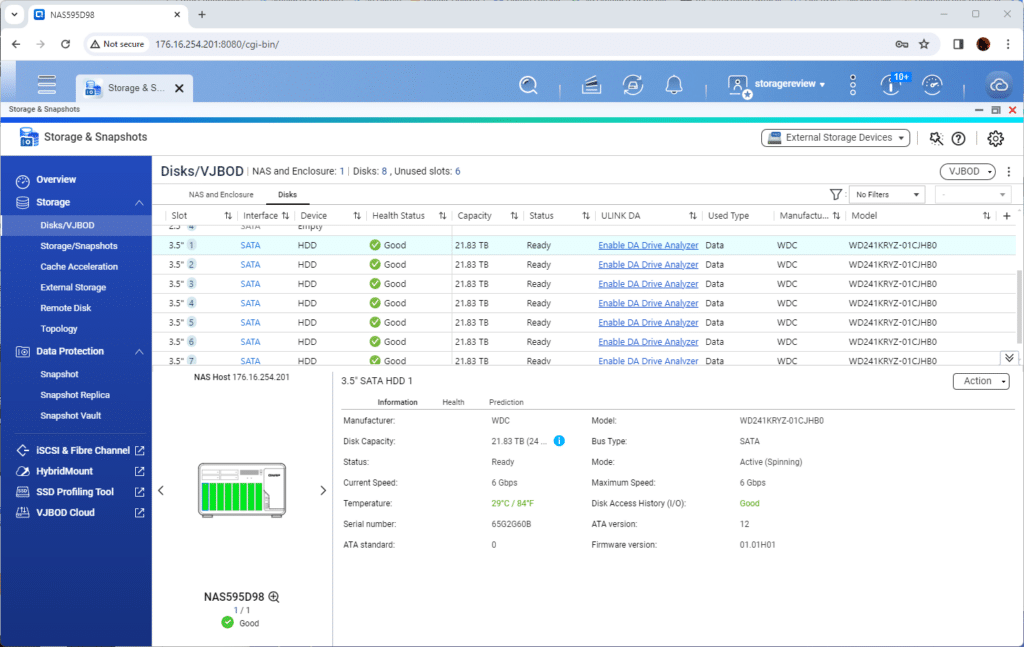
WD Gold HDD 24TB Specifications
| Model Number | WD241KRYZ |
| Form factor | 3.5-inch |
| Interface | SATA 6 Gb/s |
| 512n / 512e user sectors per drive4 | 512e |
| Formatted capacity | 24TB |
| OptiNAND technology | Yes |
| RoHS compliant | Yes |
| Performance | |
| Data transfer rate (max Sustained) | 298MB/s |
| RPM | 7200 |
| Cache | 512MB |
| Power Management | |
| Average power requirements (W) | |
| Operational | 6.8W |
| Idle | 5.5W |
| Power efficiency index (W/TB, idle) | 0.2 |
| Reliability | |
| MTBF (hours, projected) | 2,500,000 |
| Annualized Failure Rate2 (AFR, %) | 0.35 |
| Limited Warranty | 5 years |
| Environmental | |
| Operating temperature | 5°C to 60°C |
| Non-operating temperature | -40°C to 70°C |
| Shock (Read/Write)
Operating (half-sine wave, 2ms) |
40G/40G |
| Non-operating (half-sine wave, 2ms) | 200G |
| Acoustics (average) | |
| Idle Mode | 20 dBA |
| Seek Mode | 32 dBA |
| Physical Dimensions | |
| Height (max) | 26.1mm |
| Length (max) | 147.0mm |
| Width (± .01 in.) | 101.6mm |
| Weight | 1.47 lb (.67 kg)
± 10% |
Performance
Enterprise Synthetic Workload Analysis
Our enterprise hard drive benchmark process preconditions each set of drives to a steady state using the same workload with which the device will be tested. This involves a heavy load of 16 threads and an outstanding queue of 16 per thread. The device is then tested in set intervals of multiple thread/queue depth profiles to show performance under light and heavy usage. Since hard drives reach their rated performance level quickly, only the main sections of each test are graphed.
Preconditioning and Primary Steady-State Tests:
- Throughput (Read+Write IOPS Aggregate)
- Average Latency (Read+Write Latency Averaged Together)
- Max Latency (Peak Read or Write Latency)
- Latency Standard Deviation (Read+Write Standard Deviation Averaged Together)
Our Enterprise Synthetic Workload Analysis includes four profiles based on real-world tasks. These profiles have been developed to make it easier to compare to our past benchmarks and widely published values, such as max 4K read and write speed and 8K 70/30, commonly used for enterprise drives.
4K
- 100 percent Read or 100 percent Write
- 100 percent 4K
8K 70/30
- 70 percent Read, 30 percent Write
- 100 percent 8K
8K (Sequential)
- 100 percent Read or 100 percent Write
- 100 percent 8K
128K (Sequential)
- 100 percent Read or 100 percent Write
- 100 percent 128K
4K 100 Percent Read/Write
Our first test measures 4K random performance. In this test, the WD Gold hit 4,187 IOPS read and 1,417 IOPS write in SMB while showing 4,373 IOPS read and 1,398 IOPS write iSCSI.
 For average latency, the WD Gold reached 61.13ms read and 180.51ms write, and 58.52ms read/182.92ms write in SMB and iSCSI, respectively.
For average latency, the WD Gold reached 61.13ms read and 180.51ms write, and 58.52ms read/182.92ms write in SMB and iSCSI, respectively.
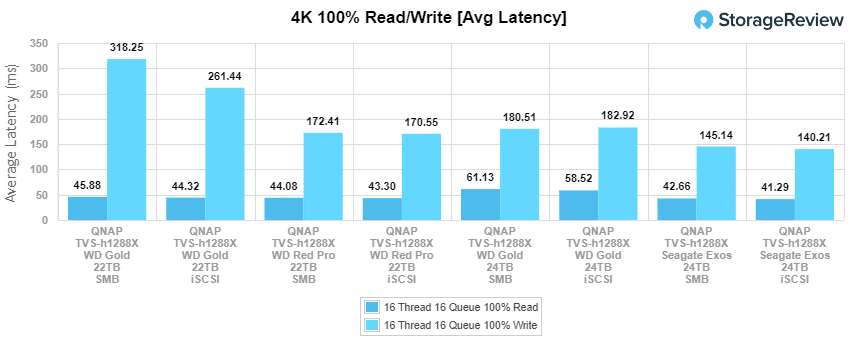
At maximum latency, the WD Gold 24TB drives recorded 759.98ms read, 4,322.5ms write in SMB, 1,228.1ms read, and a substantial 31,059ms write in iSCSI.

Regarding standard deviation, in SMB, the WD Gold hit 37.06ms for read and 373.254ms for write, while iSCSI recorded 104.53ms for read and 1,178ms for write.
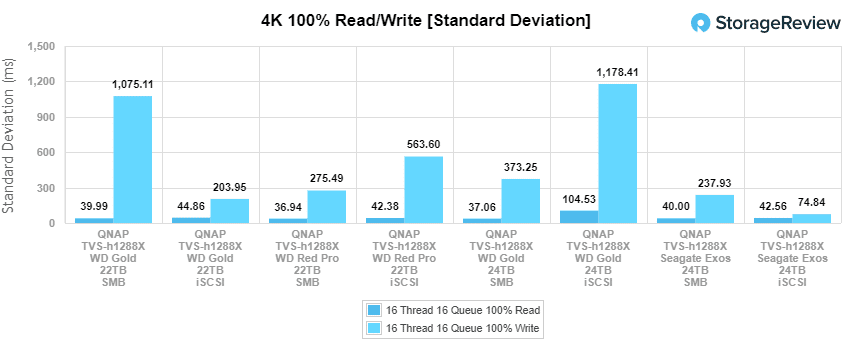
8K 100 Percent Read/Write
Both drives showed significant performance improvements in the 8K Read/Write test compared to the 4K Read/Write test. In the iSCSI setup, the 24TB WD Gold showed 157K IOPS read, 95K IOPS write for SMB, 215K IOPS read, and 228K IOPS write in iSCSI.
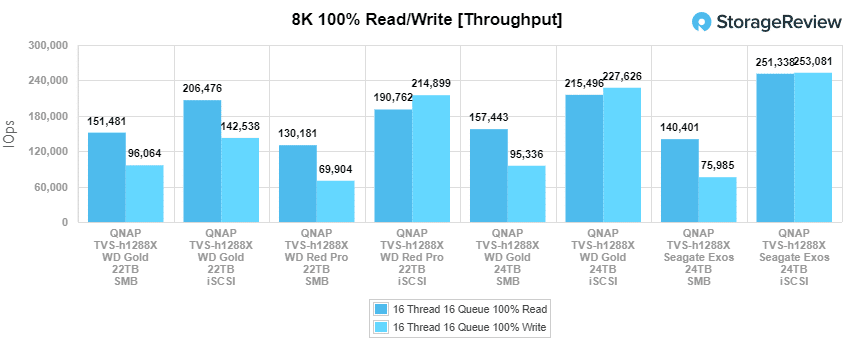
8K 70 Percent Read 30 Percent Write
The other type of workload we run shifts from a pure sequential read/write scenario to a mixed workload, demonstrating how performance scales from 2T/2Q to 16T/16Q. Here, the performance in SMB showed a minimum of 589 IOPS (coincidentally, this was the same as the 24TB Seagate Exos) and a maximum of 1,648 IOPS. With iSCSI, we see a minimum of 913 IOPS and a maximum of 1,923 IOPS, with generally consistent performance.

For average latency, we see some noticeable spikes (in SMB) as high as 152,53ms while going as low as 6ms at 2 Threads 4 Queue. We saw similar scores with iSCSI, with latency going as low as 6.78ms and a max of 132.96ms at 16 Threads 2 Queue.

Looking at max latency, WD Golds showed significantly higher latency with SMB compared to iSCSI (like the Seagate drives). Specifically in SMB, the latency started at 5,395.85ms and peaked at 5736.11ms in 16 Threads 16 Queue, whereas iSCSI showed lower and more consistent latency, starting at 1167.74ms and peaking at 3,618.97ms.

In the final part of the 8k 70/30 test, we observed that the iSCSI configuration performed better in standard deviation. Specifically, the SMB setup showed a latency as low as 24.1ms with a max of 373.75ms, while iSCSI exhibited a range of 12.29ms to 150.22ms during the test.
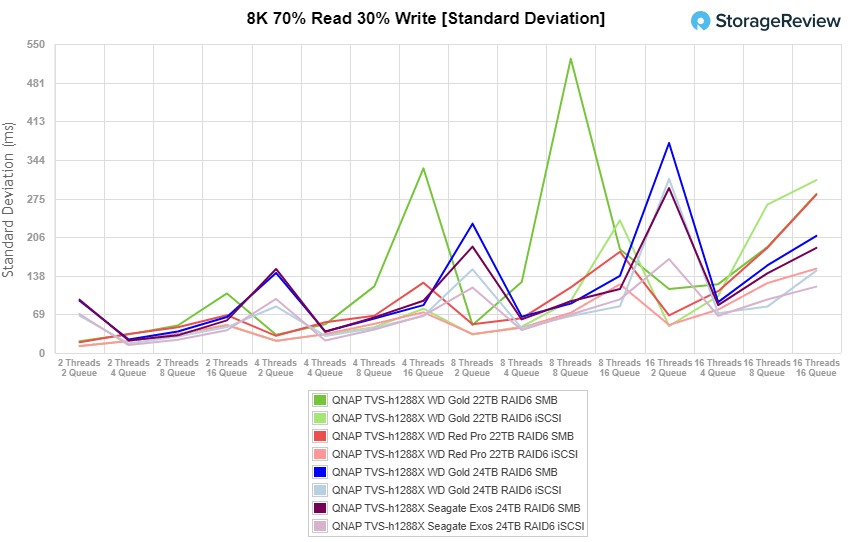
128K 100 Percent Read/Write
Our final test is the 128K 100% Read/Write test. This test involves large blocks and demonstrates the highest sequential transfer speed the drives can achieve. For SMB performance, the 24TB WD Gold achieved 1.38GB/s read, and 2.3GB/s write, hitting 2.08GB/s read and 2.27GB/s write for iSCSI.

WD Gold 24TB Pricing and Warranty
While specific pricing details can vary depending on the retailer and potential bulk purchase discounts, the WD Gold 24TB Enterprise HDD currently costs $630 at the Western Digital store and comes with a five-year limited warranty.
Conclusion
The WD Gold line marks a significant milestone in storage capacity expansion with its 24TB model. Offered exclusively in the SATA interface, this high-capacity drive is tailored to meet the rapidly increasing needs for more extensive storage solutions in enterprise environments. The 24TB model retains the characteristics that have made the Gold series a reliable choice for businesses, including a helium-filled, 7200RPM CMR SATA design. At the same time, its energy efficiency represents a reduced power consumption compared to previous models.

Regarding performance, the 24TB Gold HDD presented a complex picture in our suite of benchmarks. During our rigorous testing with eight drives in our standard QNAP NAS setup, the 24TB model indicated a dip in performance in the 4K read tests compared to its 22TB counterpart, where we noted a marked decrease in read speeds and higher latency. The Seagate Exos X24 also outperformed it.
That said, the drive’s integration of cutting-edge technologies, competitive pricing, and a solid warranty package make it a solid choice for businesses planning to expand their storage capabilities. The WD Gold series remains a relevant and dependable option for modern data centers seeking a balance between performance, reliability, and future growth potential.
Engage with StorageReview
Newsletter | YouTube | Podcast iTunes/Spotify | Instagram | Twitter | TikTok | RSS Feed

